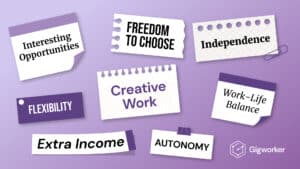As of 2017, the Bureau of Labor Statistics reported that 55 million people in the U.S. worked within the gig economy, accounting for 34% of all American workers. That number was expected to jump to 43% in 2020. But, with the Coronavirus pandemic sweeping the globe, the entire face of the gig economy has changed. Our growing dependence on it as a nation, and across the world, has also changed.
Now, people are turning toward gig workers more than ever to keep the country (and the world) up and running. With about 95% of Americans currently ordered to stay at home, people are relying on gig workers to deliver food, offer rides, keep businesses running with remote work, and even bring medication to those who can’t leave their homes.
Most people don’t think about the gig economy and how it works, and that’s really part of the point. Each job is supposed to be a one-time thing. But, if you’ve ever taken a Lyft somewhere or had food delivered via Grubhub or UberEats, you have a gig worker to thank for making your life more convenient. So what does this viral outbreak mean for the current environment of the gig economy, and how will it impact the future?
To learn more about that, it’s first important to have a full understanding of what the gig economy really is.
What is the Gig Economy?
The gig economy is a specific labor market. It is made up of gig workers (sometimes called freelancers or independent contractors) who operate on short-term contracts, single jobs, or “gigs,” rather than having one full-time or part-time job to work at each day.
- Freedom to choose which jobs/clients you take
- Flexible working hours
- Flexible location
- Independence
- A better work-life balance, according to 77% of gig economy workers
Another advantage of working in the gig economy is that in many cases, there isn’t really a “cap” on how much money you can make. Clients and gigs can be sporadic at times, but if you can find consistent work and get it done, the sky’s the limit when it comes to your earning potential. That’s especially true if you can find work in robotics, virtual reality, Instagram marketing, or another high-paying job within the gig economy.
What Are the Disadvantages of Being a Gig Worker?
While the gig economy has plenty of benefits and advantages, there are also some serious “cons” to consider, especially now as this pandemic has caused an upheaval of most people’s way of life.
First, there are several financial risks to being an independent contractor. If someone is working in the gig economy as a second job or a side hustle to make more money in their free time at home, that’s one thing. But, those who work full-time in the gig economy have a few challenges to overcome on a regular basis. For example, there may not always be consistent work available. There is no guarantee of a paycheck each week, or a specific amount of income. Sporadic work can cause a lot of stress for workers scrambling for their next gig job.
As an independent contractor, you’re essentially operating as your own business. As a result, you’re in charge of things like:
- Taxes
- Managing your hours
- Marketing yourself/your business
- Keeping track of your finances
Gig workers are also typically responsible for buying their own health insurance since they don’t have an employer to offer a healthcare plan. As of 2019, there will no longer be a penalty fee on your taxes if you don’t have healthcare coverage. But, having healthcare insurance can help you to avoid spending thousands of dollars out-of-pocket if you ever end up sick or injured and have to go to the hospital.
How Can Gig Workers Protect Themselves During an Outbreak?
As you can see, under normal circumstances, there are both pros and cons to working in the gig economy. The current coronavirus pandemic, however, has exposed the real risk for many people working in the gig economy. So much so that some workers are going on strike. At the end of March, gig workers for the grocery delivery service, Instacart, went on strike. They feel as though the company hasn’t taken active steps to ensure their safety and protect them from an illness during this outbreak. Workers had to purchase their own hand sanitizer and other protective gear, as it wasn’t supplied by the company.
The entire reason so many people are under stay-at-home orders right now, and everyone is encouraged to practice social distancing, is to slow the spread of Coronavirus. The World Health Organization (WHO) has been trying to stop the spread by:
- Identifying who is sick with the virus
- Isolating those individuals from others
- Providing the right medical care as early on as possible
- Communicating essential information to the public
For many gig workers, social distancing simply isn’t an option. If they don’t continue to work, not only will they be out of a job but life as we know it will continue to change. How many times throughout this period of social isolation have you ordered delivery from a restaurant? Have you had groceries delivered? Have you had to have prescription medication delivered, or something written about or designed for your business? If you’ve hired someone from the gig economy during this pandemic, think about how much different (and difficult) life would be without them.
For many gig workers, social distancing simply isn’t an option. If they don’t continue to work, not only will they be out of a job but life as we know it will continue to change. How many times throughout this period of social isolation have you ordered delivery from a restaurant? Have you had groceries delivered? Have you had to have prescription medication delivered, or something written about or designed for your business? If you’ve hired someone from the gig economy during this pandemic, think about how much different (and difficult) life would be without them.
These workers face a lot of potential dangers during this time. Lyft and Uber drivers, for example, have seen rides plummet in the last several weeks as people are staying at home. Unfortunately, drivers who depend on daily activity for their income have nothing to fall back on. Additionally, food delivery drivers put themselves at risk every stop they come in contact with someone at their home. Remaining as distanced from people who are sick or who are at greater risk of getting sick is one of the best ways to avoid being infected while at work. To that end, both Instacart and Postmates have recently started “contactless” delivery options that allow their drivers and customers to complete an exchange without interacting. But coronavirus can live on certain surfaces (including plastic delivery bags and supplies) for up to three days.
What Can You Do to Support the Gig Economy?
The best way to support independent contractors right now is to hire them. It’s okay to have food delivered to your home but utilize companies that are taking this virus seriously and working to protect their employees. On April 1, 2020, Senator Elizabeth Warren called on delivery services UberEats, Grubhub, DoorDash, and Instacart to increase the pay of their gig workers in an effort to compensate them for their high-risk positions during this outbreak.
- Warren also encouraged these companies to:
- Pay workers a minimum wage
- Allow workers access to receive unemployment benefits
- Guarantee at least 14 days of paid leave for anyone infected with COVID-19
- Provide protective equipment
Uber is taking steps to protect their food delivery drivers by providing disinfectants to clean out their cars, offering a “leave at door” delivery option for drivers, and offer financial assistance, as Warren suggested, for drivers who have been exposed to or infected with COVID-19. While their methods aren’t perfect, it’s clear they are working to keep their drivers safe, so you can feel good about utilizing them for your food delivery. Do your research on how companies are treating their gig workers before you decide which ones to support.
Remember, the gig economy also includes freelancers that do more “behind the scenes” work, too. If you own a company, take this time to hire an independent contractor to write for you, work on a website, or a graphic designer to create some new material. There are so many talented individuals in the gig market who could use the business right now, and they may not be able to receive the financial benefits that those with a full-time job can get.
This outbreak has truly shown the importance of the gig economy, not only in the U.S. but across the globe. Independent contractors do so much to keep our daily lives as “normal” as possible. But with such a growing need for certain positions and a dwindling need for others, it will be interesting to see if the gig economy continues to grow as originally projected, or if workers who have been at risk will seek employment elsewhere.










Good article stating the basics on Gig work.?